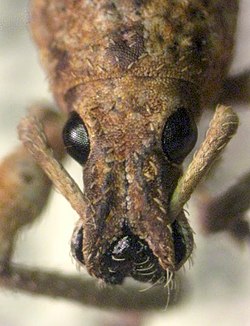Biology:Brachyomus
| Brachyomus | |
|---|---|

| |
| Head of Brachyomus octotuberculatus | |
| Scientific classification | |
| Kingdom: | Animalia
|
| Phylum: | |
| Class: | |
| Order: | |
| Family: | |
| Subfamily: | |
| Tribe: | |
| Genus: | Brachyomus Lacordaire, 1863
|
Brachyomus is a Neotropical genus of broad-nosed weevils in the subfamily Entiminae, tribe Eustylini.[1]
Taxonomy
Brachyomus was described for the first time by Jean-Baptiste Henri Lacordaire in 1863 (p. 130).[2]
Description
Members of the genus Brachyomus are easily confused with members of the genus Compsus. Members of Brachyomus lack elytral shoulders and usually bear tubercles (four or more; there are only two in Compsus when they have them) on the broadest part of the elytra. They are usually covered by brown to whitish scales, forming some patterning; they can also bear metallic green or blue scales; some species have waxy secretions at the base of the elytral tubercles. There are thick scales rather uniform;y distributed all over the surface of the body, sometimes more densely so on the elytral tubercles. There is a key to identify most species in Faust (1892).[3]
Distribution
The genus Brachyomus is distributed in Colombia, Ecuador, French Guiana, Peru, Trinidad, Venezuela and Saint Vincent[1][4][5]
List of species
Brachyomus contains 7 described species:[4][5]
- Brachyomus bicostatus Faust, 1892: 14:[3] Venezuela.
- Brachyomus histrio Faust, 1892: 14:[3] Venezuela.
- Brachyomus metallescens Pascoe, 1880: 427:[6] Ecuador, Peru.
- Brachyomus octotuberculatus (Fabricius), 1787: 112:[7] French Guiana, Trinidad, Venezuela.
- Brachyomus quadrinodosus (Boheman), 1842: 217 [8] = Brachyomus sallei Faust, 1892: 15:[3] Colombia, Venezuela.
- Brachyomus quadrituberculatus (Boheman), 1842: 216:[8] Colombia, Venezuela.
- Brachyomus tuberculatus (Boheman), 1842: 218:[8] Saint Vincent.
References
- ↑ 1.0 1.1 Alonso-Zarazaga, M. A.; Lyal, C. H. C. (1999). A world catalogue of families and genera of Curculionoidea (Insecta: Coleoptera) excluding Scolytidae and Platypodidae. Barcelona, Spain: Entomopraxis. pp. 315 pp.. https://weevil.myspecies.info/sites/weevil.info/files/Alonso-Zarazaga%20%26%20Lyal,%201999_World%20Catalogue%20%28searchable%29.pdf.
- ↑ Lacordaire, J.T. (1863). Histoire naturelle des insectes: Genera des Coléoptères ou exposé méthodique et critique de tous les genres proposés jusqu’ici dans cet ordre d’insectes. Tome Sexième. Contenant la famille des Curculionides. Paris: Librairie encyclopédique de Roret. pp. 637 pp.. https://biodiversitylibrary.org/page/9375856.
- ↑ 3.0 3.1 3.2 3.3 Faust, Johannes (1892). "Reise von E. Simon in Venezuela. Curculionidae. Pars prima". Entomologische Zeitung 53: 1–44. https://www.biodiversitylibrary.org/part/101192.
- ↑ 4.0 4.1 Wibmer, G. J.; O'Brien, C. W. (1986). "Annotated checklist of the weevils (Curculionidae sensu lato) of South America (Coleoptera: Curculionoidea)". Memoirs of the American Entomological Institute 39: 1–563.
- ↑ 5.0 5.1 O’Brien, C.W.; Wibmer, G.J. (1982). "Annotated checklist of the weevils (Curculionidae sensu lato) of North America, Central America, and the West Indies (Coleoptera: Curculionoidea)". Memoirs of the American Entomological Institute 34: 1–382.
- ↑ Pascoe, F.P. (1880). "New Neotropical Curculionidae. Part I". The Annals and Magazine of Natural History 5: 419–428. https://biodiversitylibrary.org/page/16336574.
- ↑ Fabricius, Johann Christian (1787) (in la). Mantissa insectorum sistens eorum species nuper detectas adiectis characteribus genericis, differentiis specifis, emendationubus, observationibus. Hafniae: Proft. pp. XX + 348 pp.. https://books.google.com/books?id=KYo-AAAAcAAJ&.
- ↑ 8.0 8.1 8.2 Schönherr, C.J. (1842). Genera et species Curculionidum, cum synonymia hujus familiae. Species novae aut hactenus minus cognitae, descriptionibus a Dom. Leonardo Gyllenhal, C. H. Boheman, et entomologis aliis illustratae, tomus sextus, pars secunda. Paris: Roret. pp. 495 pp.. https://www.biodiversitylibrary.org/page/4115130.
Wikidata ☰ Q14924542 entry
 |

